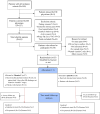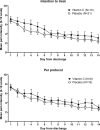Impact of vitamin C on the reduction of opioid consumption for acute musculoskeletal pain: A double-blind randomized control pilot study
- PMID: 39739762
- PMCID: PMC11687786
- DOI: 10.1371/journal.pone.0316450
Impact of vitamin C on the reduction of opioid consumption for acute musculoskeletal pain: A double-blind randomized control pilot study
Abstract
Introduction: Recent evidence has shown that vitamin C has analgesic and opioid sparing properties in immediate postoperative context. However, this has never been studied for acute musculoskeletal (MSK) emergency department (ED) injuries. The aim of this pilot study is to evaluate the feasibility of conducting a randomized placebo-controlled study to determine the opioid sparing and analgesic effect of vitamin C compared to placebo, in acute MSK injured ED patients.
Methods: A double-blind randomized controlled trial (RCT) distributed in two arms, stratified for fractures, was performed in a tertiary care center, one group receiving 1 g of vitamin C twice a day for 14 days and another receiving placebo. Participants were ≥18 years of age, treated in ED for MSK injuries present for ≤2 weeks, and discharged with a standardized opioid prescription of 20 morphine 5 mg tablets (M5T) and, at the clinician discretion, 28 tablets of naproxen 500 mg. Participants completed a 14-day paper diary and were contacted by phone at 14 days, to document their analgesic use, vitamin C consumption, and pain intensity.
Results: Overall, 137 patients were screened; 44(32%) were excluded, 38(40.9%) refused, leaving 55(59.1%) participants, with a consent rate of 9.2/month. Mean age was 53 years (SD = 16) and 55% were men. Fourteen (25%) participants were lost to follow-up and 33(83%) patients complied with treatment. For per-protocol analysis, the median (IQR) M5T consumed was 6.5 (3.3-19.5) for the vitamin C and 9.0 (1.5-16.0) for placebo group. The median (IQR) naproxen 500 mg tablets consumed was 0 (0-9.8) for the vitamin C group and 20 (0-27) for the placebo arm.
Conclusion: This pilot study supports the feasibility of a larger RCT on the opioid sparing and analgesic properties of vitamin C for acute MSK injured ED patients. Strategies to reduce the refusal and lost to follow-up rates are discussed.
Trial registration number: NCT05555576, ClinicalTrials.Gov PRS.
Copyright: © 2024 Daoust et al. This is an open access article distributed under the terms of the Creative Commons Attribution License, which permits unrestricted use, distribution, and reproduction in any medium, provided the original author and source are credited.
Conflict of interest statement
The authors have declared that no competing interests exist.
Figures
Similar articles
-
Impact of vitamin C on the reduction of opioid consumption after an emergency department visit for acute musculoskeletal pain: a double-blind randomised control trial protocol.BMJ Open. 2023 May 24;13(5):e069230. doi: 10.1136/bmjopen-2022-069230. BMJ Open. 2023. PMID: 37225265 Free PMC article.
-
Quantity of opioids consumed following an emergency department visit for acute pain: a Canadian prospective cohort study.BMJ Open. 2018 Sep 17;8(9):e022649. doi: 10.1136/bmjopen-2018-022649. BMJ Open. 2018. PMID: 30224393 Free PMC article.
-
Low-dose ketamine improves pain relief in patients receiving intravenous opioids for acute pain in the emergency department: results of a randomized, double-blind, clinical trial.Acad Emerg Med. 2014 Nov;21(11):1193-202. doi: 10.1111/acem.12510. Acad Emerg Med. 2014. PMID: 25377395 Clinical Trial.
-
Perioperative intravenous ketamine for acute postoperative pain in adults.Cochrane Database Syst Rev. 2018 Dec 20;12(12):CD012033. doi: 10.1002/14651858.CD012033.pub4. Cochrane Database Syst Rev. 2018. PMID: 30570761 Free PMC article.
-
Low-dose ketamine as an adjunct to morphine: A randomized controlled trial among patients with and without current opioid use.Acad Emerg Med. 2024 Oct;31(10):961-968. doi: 10.1111/acem.14983. Epub 2024 Jul 16. Acad Emerg Med. 2024. PMID: 39014886 Clinical Trial.
References
Publication types
MeSH terms
Substances
Associated data
LinkOut - more resources
Full Text Sources
Medical




